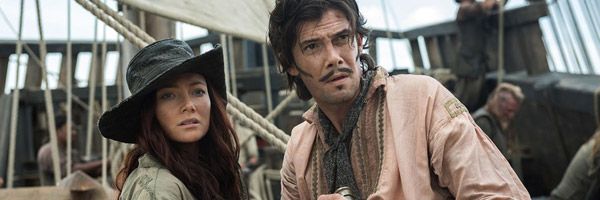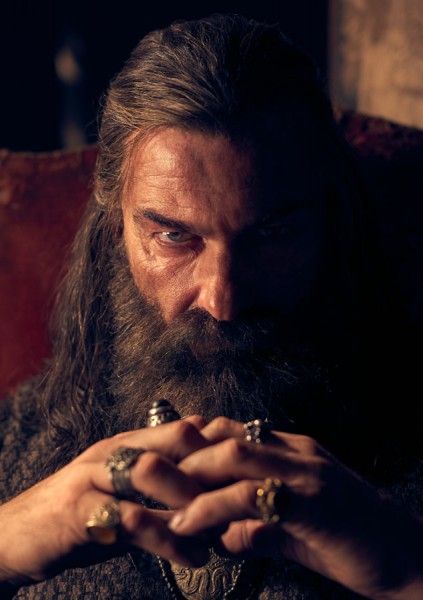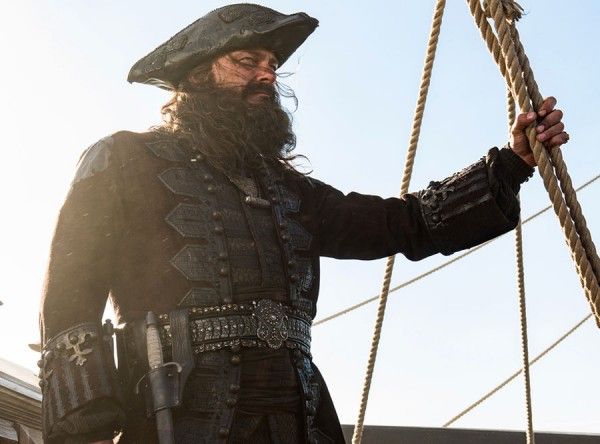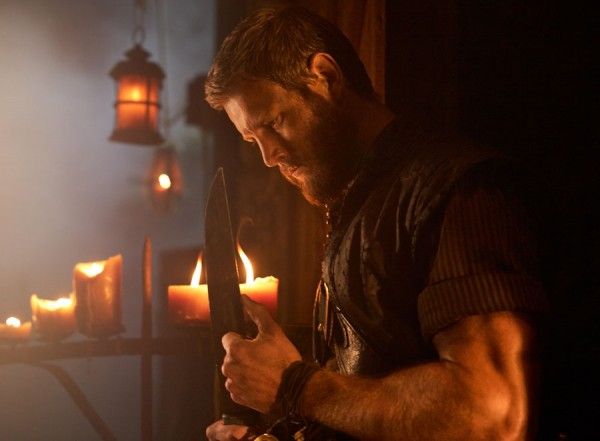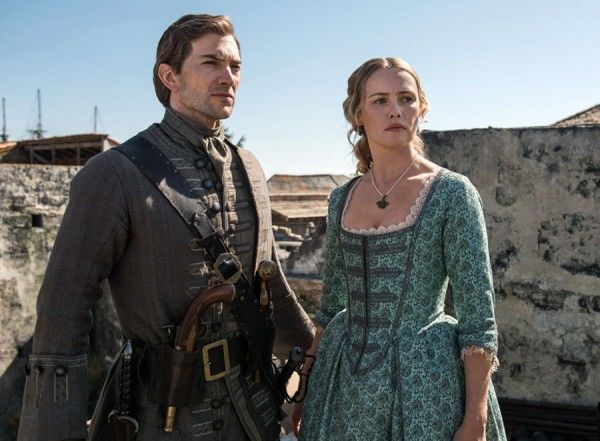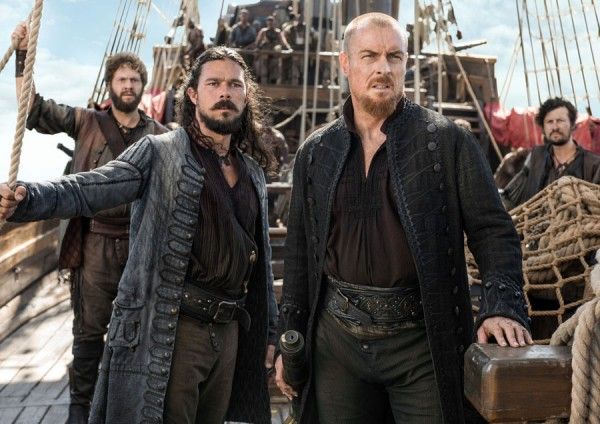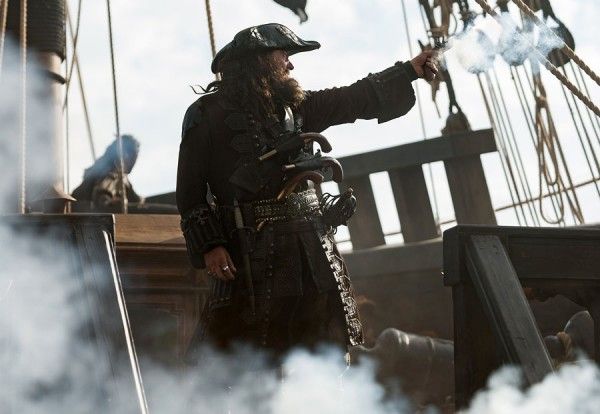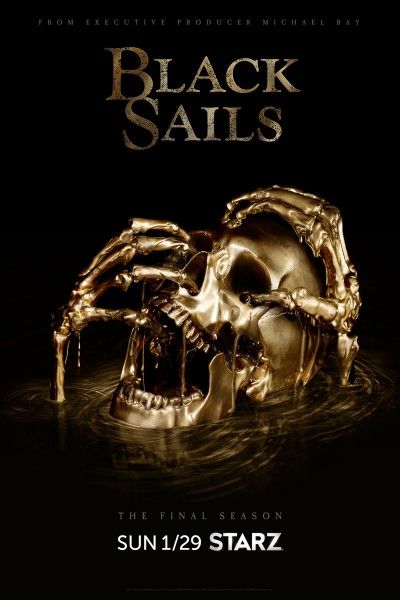On the fourth and final season of the Starz drama series Black Sails, things are ramping up, as Captain Flint (Toby Stephens) hopes to strike the final blow against civilization and take back Nassau. But in order to succeed, Flint must rely on Silver (Luke Arnold), who is trying to figure out if he’s really capable of living up to the Long John Silver myth.
During this recent exclusive interview with Collider, executive producers/co-showrunners Jon Steinberg and Robert Levine talked about the show’s most recent shocking death, deciding just how that character would meet his end, how that death will affect things going forward, where Jack Rackham (Toby Schmitz) and Anne Bonny (Clara Paget) go next, the Billy Bones (Tom Hopper) and Captain Flint dynamic, the role of Israel Hands (David Wilmot), the women of Nassau, and what they’re most proud of accomplishing with this series. Be aware that there are some major spoilers discussed.
Collider: I’m excited to be talking to you about this season of Black Sails, but I’m also sad that it’s the final season. And Episode 3 of this last season was a real tough one to watch, with that horrific death season.
JON STEINBERG: Somebody asked if there is anything more disturbing coming down the road, and it’s a definitive no. That’s a ten out of ten on the gross scale for us.
We know that most of these pirates are likely to die, in some horrible way, this season. How did you decide the way Blackbeard would meet his end, along with the way you wanted to capture his demise?
STEINBERG: It was complicated, in the sense that there were certain things we knew his death needed to do. We knew it needed to be a spectacle, within that world. It needed to be something that added to the legend of him. We knew we wanted it to be a moment in which we could see Woodes Rogers really expose the kinds of cruelty he was capable of and the darkest of his dark side. And we knew that the added complication was that we wanted to somehow, in the midst of it, have Teach save Rackham’s life. When we combined all of those things and tried to figure out what it was going to look like, it matched up perfectly with this set piece that we’ve been aware of for awhile, but just never really felt tempted to do, in terms of the keelhaul, until it was the right moment. All of those things lined up neatly, to make this feel like it was the time to do it, and that it was going to send off this character that we’ve become really invested in, in a big, mythic way.
Were there conversations or any input from Ray Stevenson into how he saw it all playing out, or did he just have to deal with whatever make-up, prosthetics and crazy stuff that you threw at him?
STEINBERG: He dealt with a lot of make-up and crazy stuff. He was a total trooper through hours and hours of sitting in that chair for prosthetics. It was really important to Ray that we respect the historical record, through the whole run of this character, but specifically with the way he went out, and it was really important to us, too. At the same time, he really appreciated that it isn’t just the historical Blackbeard’s story we’re telling. It’s the story of this character who is distinctly a part of this show. The challenge was to figure out how to serve both. While the details of this stuff don’t match the historical record – he was keelhauled and it wasn’t done by the Governor of New Providence Island in the Bahamas – it was done for the sake of spectacle and his body was made a symbol of, afterwards. So, there were truths to it that felt right, even if the details were adapted for the sake of the show.
How long did that scene take to shoot and what were the biggest challenges in having it turn out the way that we saw it?
ROBERT LEVINE: I don’t remember the number of days, but it was an elaborate sequence, so it was many, many days. Keelhauling is something that’s familiar, as a term, but maybe not in its specifics. We were surprised, as we dove into the research, to find that there wasn’t a ton of explanations about what it actually was. It gave you the sense that it was something that was leveled more as a threat than as something that was ever followed through on. So, we had to figure out how you’d do it, not just for the sake of filming it, but for the sake of the logistics and story. I guess you could say that was fun, but not with a capital F. We figured out how to do it in a way that would make it the most visually and dramatically effective, and you saw the results.
How will the death of Blackbeard affect things, going forward?
STEINBERG: As much as we try to be careful about killing characters off, there comes a point sometimes where you’re just staring at a story reality that’s impossible to deny, which is that, if Long John Silver is going to be the new king of the pirates, the old one has to be gone. The passing of the torch from the old generation, or the guys from the old neighborhood, to this character who we’ve known for the run of the show, but who has only, very recently, become the character from Treasure Island and assumed that identity, it had to happen. I think we tried to be careful in making sure that Teach was dead before we had scenes where we felt our Silver was Long John Silver. There can only be one of them, at a time. I think that’s a big deal. And it’s a moment where Rackham starts to get a sense that his place in the mythology of piracy might be a little different than he thought it was going to be. He isn’t one of those guys and he doesn’t have the capacity that Teach has. He wouldn’t have handled things that way. He wouldn’t have been strong enough to do what Teach did, in surviving that long. He has to find a new place for himself and a new type of legacy that he can try to leave behind.
After seeing what happen to Vane and then watching what happened to Teach, where do Rackham and Bonny go from there?
LEVINE: Nowhere good. It’s going to be difficult. It becomes a challenge for Rackham, both in the immediate life and death stakes, but also in a broader sense of someone who is always looking for his place in the world and thought he had it. He’d finally come to a place where he felt like he was a peer of Blackbeard, and there was a certain peace in that for him and Bonny. They felt like, “Once this war is over, we can move on.” Now, that’s not possible, in a couple directions. There’s more figuring out to do. The rest of the season, for both of them, is very much devoted to that question.
The fighting and action sequences on this show have always been great and have always been very impressive, but this season feels like you’re going above and beyond anything you’ve ever done before. Were there conversations about going all out because it’s the final season and just topping everything we’ve seen on the show, up until now, or was it just about following the story you’re telling?
STEINBERG: I think we got to the point where we felt like we weren’t sure how to do a fifth season of this because the bar had been raised to this degree. At the turn of each season – going into Season 2, 3, and then 4 – the challenge we set for ourselves was to not repeat anything and do it bigger. At a certain point, you just start to run into the laws of time and space with what’s possible for the production. With Season 4, we really challenged ourselves to figure out what we hadn’t seen yet and what are things that we could do in this world that we hadn’t seen on any show. In the process of trying to execute that, at some point during the fourth season, we started to have that feeling of, “I don’t know that the bar goes higher than this, in terms of the kinds of things you can do in this world.” It was one of a number of indications that the show was probably coming to an end.
Billy Bones finally faced off with Flint, which was a long time coming. What was that like to finally get to play out, and to continue to play out those moments that you’ve been leading up to?
LEVINE: There is satisfaction in that, certainly when you feel like something has been earned. Obviously, a showdown between Flint and Billy is something that we’ve gone to great lengths to not just make plausible, but also deny until it couldn’t be denied anymore because the implications would be so massive for everyone involved. There’s always the challenge of, even in that moment, how do you surprise the audience? If they can see it coming, how do you make the outcome something that still manages to take them by surprise? That’s not always easy.
Can they still fight on the same side, or is their relationship permanently broken?
LEVINE: As writers, you want to figure out a way to get them back in a room together because those scenes are going to be so charged and so hot. They have a lot to do with each other, from here on out, but at the same time, there are things that happen that can’t be gone back from.
Israel Hands had a real moment, at the end of Episode 3. Why does he make a good ally for the pirates, and what can we expect to see from him next?
STEINBERG: It’s a character we’ve known needed to be a part of this story before it could be over. He’s so important to the Treasure Island canon and to our understanding of Long John Silver in that book, that it felt like not only a good opportunity, but a necessary component of understanding who Long John Silver is. What we saw, almost immediately in Episode 2, and then going forward, is that he is having the effect of forcing John Silver to really play the role and to not be able to turn back and to not treat it like it’s theater. He only has the support of this guy, who is his maybe his most important piece of muscle, as long as he is portraying the strong leader. That felt interesting. In a way, Israel Hands was the gun at John Silver’s back, forcing him to put the suit on and become this guy. It was a way to do what we’re always trying to do, which is take Treasure Island mythology and turn it upside down and add wrinkles to it. If you were to read the book, after this show, it would force you to look at things a little bit differently.
At this point, if it came down to it, do you think Silver could live up to the Long John Silver myth, or does he still have a little ways to go before he can be who everyone thinks he is?
STEINBERG: One of the main story trunks for this season is watching that process and figuring out if the character of Long John Silver will consume the guy who is trying to step into it, or whether the guy can step into it and make it work for him, and how those two identities are intention from the moment they come into contact with each other, at the beginning of Season 4. It’s about who’s going to win and who is going to be left in control of the story, at the end of it.
Eleanor and Max are in a very interesting place. What’s next for the women of Nassau?
LEVINE: In Max’s case, she wants this all to be over with. She said as much to Silver. She’s done with having to be forced to choose sides when both sides don’t seem interested in bringing this to a reasonable resolution, anytime soon. She has enough perspective to just see that this will just continue and continue until someone makes a conscious choice to stop. Can she get herself into a position where she’s the person to do that? We’ll see. And for Eleanor, she’s determined to not live up to what Vane tarred her with, in Season 3, that she’s someone who betrays. She’s in love with Woodes Rogers and she’s determined to stay loyal to him and do whatever she has to do to get him through this. It’s that idea of, what is betrayal, that is going to be tested for her.
What can we still expect to see from Flint’s journey?
STEINBERG: You see it forming already, in the first three episodes, that Flint is now fixed on a goal upon which he can focus all of this energy he has towards the British Empire and Woodes Rogers, and that’s this massive revolt. To him, it’s a complete system failure of the British colonial system in the New World. And then, from his first lines of dialogue in the premiere, it’s just about, can I hold this together and drag it across the finish line? The goal for us was to throw as many flaming chainsaws at him as we could, in the process, to make it almost impossible, if not impossible, and then watch how he reacts to that. And then, the dramatic question is, which is the chainsaw and who is the one that’s eventually going to stop it from happening because clearly it never happened, and what does that mean to him and to the person who ends up throwing it? I think the dramatic journey for Flint is that he’s the first person in the run of the show to actually see a version of the thing he’s idealized, from the beginning, and has it within his grasp. For everyone else, that’s always been a bit of a compromised vision. In this moment, he’s actually within striking distance of it. The tragedy of it is that he needs this other guy, in Silver, to make it work. I think you know, from the moment the show starts in Season 1, that things probably aren’t going to end in a terribly happy way for the two of them. It’s just really a question of why, what does it, what affect does it have on them, and what does the aftermath look like?
Are there any storylines or characters that you wish you’d had more time with, but weren’t able to because you had to push the story forward in a different direction?
STEINBERG: Yeah, for sure!
LEVINE: When a character dies, almost by nature of wanting the death to feel dramatic, it needs to feel too soon. It needs to feel abrupt and unsettling. That’s not just an internal dramatic thing, but that’s also something that we feel, as writers. Miranda Barlow was a beloved character. Charles Van was a beloved character. They’re fun to write. To know that that’s not there anymore is always a challenge because if they’re on the show and they’re integral than they’re working.
When you look at this series as a whole, what are you most proud of, when it comes to the story you were able to tell, over these four seasons, and what do you think you’ll miss most about being able to live in this world with these characters?
STEINBERG: In terms of what I’ll miss most is that it really is a world that allows you to do a lot of things, all at the same time. And it’s a world that I think has let us make a big action show that is an epic adventure. It’s a show with a world that has allowed us to tell what I hope is an interesting story about what happens when you step outside of civilization, and what happens when someone’s identity isn’t defined for them by social norms and they have to wrestle with it for themselves. It doesn’t happen that often, that you get a show that will scale up to as big as you could possibly make it, as a production reality, and will scale down to really intimate, quiet moments between characters, and this show has let us do that. I think all of us really were aware, through the fourth season, that there were some opportunities we were getting with this show, that may never come back again.
Watching this series has been such a pleasure and I’ve been so impressed, not only with what you’ve pulled off on TV, but also how it’s better than what’s in most films. It’s also such a fascinating cast of characters with incredible actors playing them.
STEINBERG: We got very, very lucky with this cast, and not just in the ways that show up on screen, in terms of how talent they are, how committed they are and how prepared they are, but also in terms of how much fun they were to be around. You’re in no way entitled, as a producer, when you start a show like this, that everybody is actually going to get along and enjoy each other’s company. When that happens, you just know, on some level, it’s never going to be this good again, or if it is, it will be lightning striking twice.
Black Sails airs on Sunday nights on Starz.

